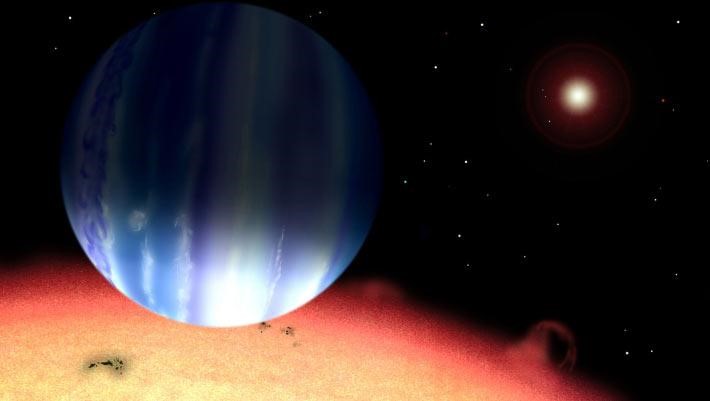2021 August: SPIRou reveals the atmosphere of Tau Boo b
The atmosphere of the giant exoplanet Tau Boo b was investigated with SPIRou.
Using the SPIRou spectropolarimeter on the Canada-France-Hawaii Telescope (CFHT) in Hawaii, a team gathering core SPIRou scientists led by Stefan Pelletier, PhD student at Université de Montréal, studied the atmosphere of the gas giant exoplanet Tau Boo b, a scorching hot world that takes a mere three days to orbit its host star.

Their detailed analysis, published in the Astronomical Journal on 2021 July 28, shows that the atmosphere of the gaseous planet Tau Boo b contains carbon monoxide, as expected, but surprisingly no water, a molecule that was thought to be prevalent and should have been easily detectable with SPIRou.
Tau Boo b is a planet about 6x more massive than Jupiter but 100x times closer to its parent star than Jupiter is to the Sun, hence its classification as a ‘hot Jupiter’. Its host star, Tau Boo, is located only 51 light-years from the Earth in the Bootis constellation, and is visible to the naked eye. Tau Boo b was one of the first exoplanets ever discovered, in 1996, thanks to the radial velocity method, through the slight back-and-forth motion of the star induced by the gravitational tug of its planet. Although the atmosphere of Tau Boo b had been studied before, it is the first time its molecular content is investigated with as powerful an instrument as SPIRou.
Assuming Tau Bootis b formed in a protoplanetary disk with a composition similar to that of our Solar System, models show that water vapor should be present in large quantities in its atmosphere, thereby easily detectable with SPIRou. The team expected a strong detection of water with maybe a little carbon monoxide, but was surprised to find the opposite, ie carbon monoxide but no water.
Hot Jupiters like Tau Boo b offer an unprecedented opportunity to probe giant planet formation, the planet composition and in particular the molecular atmospheric composition giving clues as to where and how the giant planet formed. The extreme temperature of hot Jupiters allows most molecules in their atmospheres to be in gaseous form, and therefore detectable with instruments like SPIRou.
In our Solar System, Jupiter and Saturn are cold enough for some molecules, such as water, to be frozen and hidden deep in their atmospheres, making it hard for us to determine their abundance. Studying hot Jupiters thus provides a way to better understand the formation of giant planets, including those of the Solar System. The low amount of water on Tau Boo b may indicate that Jupiter is also drier than we had previously thought. Through their analysis of SPIRou data, Pelletier and his colleagues were able to conclude that Tau Boo b’s atmosphere features about as much Carbon as Jupiter’s, and 5x more than the Sun’s. This result strengthens the idea that hot Jupiters form much further from their host star, at distances that are similar to the giant planets of our Solar System, and experienced a different evolution, including a migration towards the star. It also suggests that, composition wise, hot Jupiters may not be that different from Jupiter and Saturn despite being located much closer to their host stars.
SPIRou: a unique instrument
Tau Boo b is one of the first planets whose atmosphere was scrutinized with SPIRou since this new instrument was installed at CFHT. SPIRou was designed, constructed and tested by an international consortium led by IRAP / OMP / CNRS in Toulouse, France. SPIRou can analyze the thermal light emitted by the planet itself in an unprecedentedly large range of colors, and with a resolution that allows for the identification of many molecules, like water, carbon monoxide, or methane. The team spent 20 hours observing Tau Boo with SPIRou at CFHT between April 2019 and June 2020, measuring the abundance of all major molecules containing either carbon or oxygen, the two most abundant elements in the universe after hydrogen and helium, to get a complete picture of the atmospheric content of Tau Boo b.


